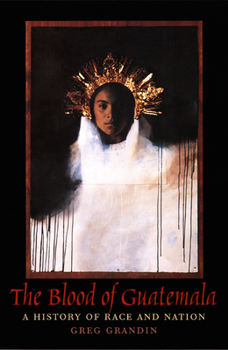The Blood of Guatemala: A History of Race and Nation
Select Format
Select Condition 
Book Overview
Over the latter half of the twentieth century, the Guatemalan state slaughtered more than two hundred thousand of its citizens. In the wake of this violence, a vibrant pan-Mayan movement has emerged, one that is challenging Ladino (non-indigenous) notions of citizenship and national identity. In The Blood of Guatemala Greg Grandin locates the origins of this ethnic resurgence within the social processes of eighteenth- and nineteenth-century state formation rather than in the ruins of the national project of recent decades.
Focusing on Mayan elites in the community of Quetzaltenango, Grandin shows how their efforts to maintain authority over the indigenous population and secure political power in relation to non-Indians played a crucial role in the formation of the Guatemalan nation. To explore the close connection between nationalism, state power, ethnic identity, and political violence, Grandin draws on sources as diverse as photographs, public rituals, oral testimony, literature, and a collection of previously untapped documents written during the nineteenth century. He explains how the cultural anxiety brought about by Guatemala's transition to coffee capitalism during this period led Mayan patriarchs to develop understandings of race and nation that were contrary to Ladino notions of assimilation and progress. This alternative national vision, however, could not take hold in a country plagued by class and ethnic divisions. In the years prior to the 1954 coup, class conflict became impossible to contain as the elites violently opposed land claims made by indigenous peasants.
This "history of power" reconsiders the way scholars understand the history of Guatemala and will be relevant to those studying nation building and indigenous communities across Latin America.
Focusing on Mayan elites in the community of Quetzaltenango, Grandin shows how their efforts to maintain authority over the indigenous population and secure political power in relation to non-Indians played a crucial role in the formation of the Guatemalan nation. To explore the close connection between nationalism, state power, ethnic identity, and political violence, Grandin draws on sources as diverse as photographs, public rituals, oral testimony, literature, and a collection of previously untapped documents written during the nineteenth century. He explains how the cultural anxiety brought about by Guatemala's transition to coffee capitalism during this period led Mayan patriarchs to develop understandings of race and nation that were contrary to Ladino notions of assimilation and progress. This alternative national vision, however, could not take hold in a country plagued by class and ethnic divisions. In the years prior to the 1954 coup, class conflict became impossible to contain as the elites violently opposed land claims made by indigenous peasants.
This "history of power" reconsiders the way scholars understand the history of Guatemala and will be relevant to those studying nation building and indigenous communities across Latin America.
Format:Paperback
Language:English
ISBN:0822324954
ISBN13:9780822324959
Release Date:March 2000
Publisher:Duke University Press
Length:368 Pages
Weight:0.50 lbs.
Dimensions:1.1" x 6.2" x 9.3"
Customer Reviews
2 ratings
Exhaustive and well written
Published by Thriftbooks.com User , 14 years ago
A reworking of Grandin's dissertation, "The Blood of Guatemala" refers to the both the national/ethnic/racial identities that defined Guatemala throughout its history and also the literal blood that flowed during the 30 year civil war in which the most repressive state in the hemisphere slaughtered two hundred thousand of its citizens. The narrative centers on Mayan elites of the town of Quetzaltenango (a place name that will probably give trouble to any English-based spell checking program) in the western highlands of Guatemala. It tells the history of the indigenous people, the Spanish conquerors and the Ladino bourgeoisie through the centuries by highlighting several key events: a demonstration in 1784 against state monopoly of liquor production that gave three Spaniards control of much of the economic life and police power in the area, a demonstration that became a riot that almost turned into an insurrection; the 1837 cholera epidemic, part of the world-wide spread of that disease, and the way it was handled and mishandled by national government; and the rise of coffee capitalism and the creation of an export economy based on plantations in the lowlands. Grandin does an excellent job with a complicated set of subjects that include caste, class and national identity and a changing array of ethnic classifications depending on who was in power (who was doing the classifying and who it benefited) at various times. Recommended for those with some knowledge of the history of Guatemala. An understanding of how historians and ethnographers work and some familiarity with academic prose generally would be helpful but not essential to profit from this book
brilliant and imaginative
Published by Thriftbooks.com User , 25 years ago
"Anyone interested in Latin American history will enjoy this myth-and-stereotype-shattering study of Mayan cultural and national identity. Thick with novelistic detail and anecdote, brilliantly and imaginatively researched, totally engrossing in its melding of convincing analysis and strong narrative sweep, Grandin takes us to a 'high place' and guides us back over the tangled, treacherous paths that led there"






